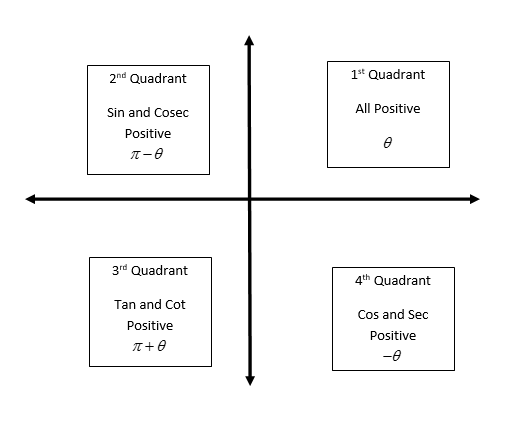
Find the general value of $\theta $which satisfies both$\sin \theta = - \dfrac{1}{2}$ and $\tan \theta = \dfrac{1}{{\sqrt 3 }}$ simultaneously.
A.$\theta = \dfrac{{4\pi }}{3}$
B.$\theta = \dfrac{\pi }{3}$
C.$\theta = - \dfrac{{4\pi }}{3}$
D.None of this.
Answer
574.8k+ views
Hint: We need to know about values of trigonometry function at different angles according to in which quadrant the values lie. A trick is used which is very useful in solving such types of problems.
A coordinate diagram is used which given as

Complete Step by step solution:
According to this question we have,
$\operatorname{Sin} \theta = \dfrac{{ - 1}}{2}$and$\operatorname{Tan} \theta = \dfrac{1}{{\sqrt 3 }}$
Let us consider,
$\operatorname{Sin} \theta = \dfrac{{ - 1}}{2}$
We know that
$\sin \theta = \dfrac{1}{2} \Rightarrow \theta = \dfrac{\pi }{6}$
But our $\sin \theta $ values is negative that means it can be \[{3^{rd}}\] or \[{4^{th}}\] Quadrant
Then its $\theta $ values will be
For 3rd quadrant, $\pi + \theta = \pi + \dfrac{\pi }{6} = \dfrac{{7\pi }}{6}$
For 4th quadrant, $ - \theta = - \dfrac{\pi }{6}$
Similarly, let us consider
$\operatorname{Tan} \theta = \dfrac{1}{{\sqrt 3 }}$
$\theta = \dfrac{\pi }{6}$
We know that $\tan \theta $ gives positive value in \[{1^{st}}\] and \[{3^{rd}}\] quadrant then values of $\theta $ will be
For \[{1^{st}}\]quadrant, $\theta = \dfrac{\pi }{6}$
For 3rd quadrant, $\pi + \theta = \pi + \dfrac{\pi }{6} = \dfrac{{7\pi }}{6}$
We will consider the common value which satisfies both functions.
We have only value which satisfies both equation is $\theta = \dfrac{{7\pi }}{6}$
Hence the correct option is\[D\].
Note: The knowledge of trigonometry function where these are positive or negative in which quadrant. Remember the all standard values at corresponding angle theta.Know the sign of the corresponding trigonometric ratios in the respective quadrants
A coordinate diagram is used which given as

Complete Step by step solution:
According to this question we have,
$\operatorname{Sin} \theta = \dfrac{{ - 1}}{2}$and$\operatorname{Tan} \theta = \dfrac{1}{{\sqrt 3 }}$
Let us consider,
$\operatorname{Sin} \theta = \dfrac{{ - 1}}{2}$
We know that
$\sin \theta = \dfrac{1}{2} \Rightarrow \theta = \dfrac{\pi }{6}$
But our $\sin \theta $ values is negative that means it can be \[{3^{rd}}\] or \[{4^{th}}\] Quadrant
Then its $\theta $ values will be
For 3rd quadrant, $\pi + \theta = \pi + \dfrac{\pi }{6} = \dfrac{{7\pi }}{6}$
For 4th quadrant, $ - \theta = - \dfrac{\pi }{6}$
Similarly, let us consider
$\operatorname{Tan} \theta = \dfrac{1}{{\sqrt 3 }}$
$\theta = \dfrac{\pi }{6}$
We know that $\tan \theta $ gives positive value in \[{1^{st}}\] and \[{3^{rd}}\] quadrant then values of $\theta $ will be
For \[{1^{st}}\]quadrant, $\theta = \dfrac{\pi }{6}$
For 3rd quadrant, $\pi + \theta = \pi + \dfrac{\pi }{6} = \dfrac{{7\pi }}{6}$
We will consider the common value which satisfies both functions.
We have only value which satisfies both equation is $\theta = \dfrac{{7\pi }}{6}$
Hence the correct option is\[D\].
Note: The knowledge of trigonometry function where these are positive or negative in which quadrant. Remember the all standard values at corresponding angle theta.Know the sign of the corresponding trigonometric ratios in the respective quadrants
Recently Updated Pages
Master Class 10 General Knowledge: Engaging Questions & Answers for Success

Master Class 10 Computer Science: Engaging Questions & Answers for Success

Master Class 10 English: Engaging Questions & Answers for Success

Master Class 10 Social Science: Engaging Questions & Answers for Success

Master Class 10 Maths: Engaging Questions & Answers for Success

Master Class 10 Science: Engaging Questions & Answers for Success

Trending doubts
The shortest day of the year in India

Why is there a time difference of about 5 hours between class 10 social science CBSE

Write a letter to the principal requesting him to grant class 10 english CBSE

What is the median of the first 10 natural numbers class 10 maths CBSE

The Equation xxx + 2 is Satisfied when x is Equal to Class 10 Maths

State and prove converse of BPT Basic Proportionality class 10 maths CBSE




